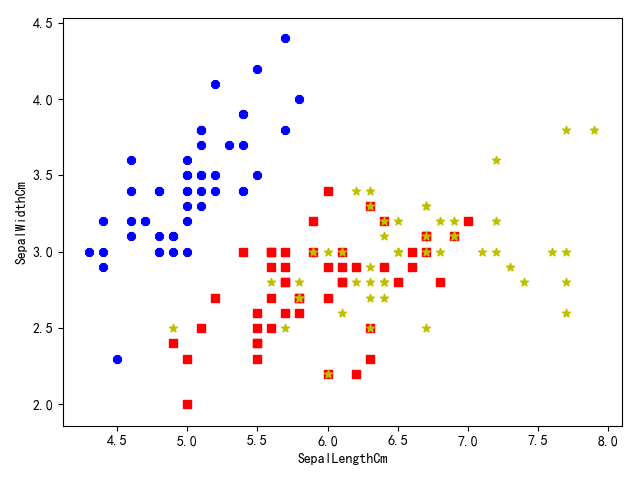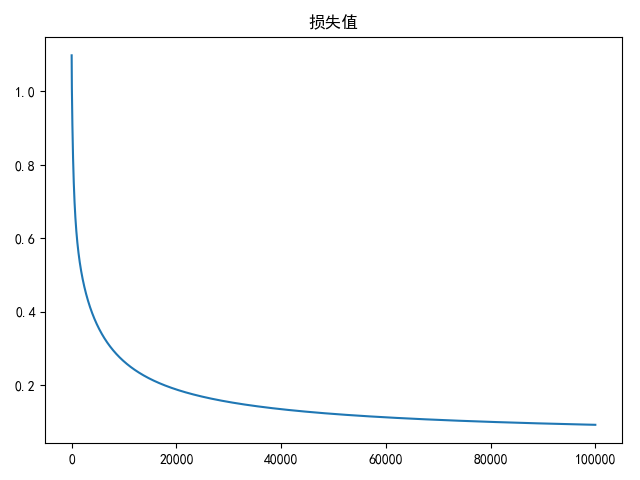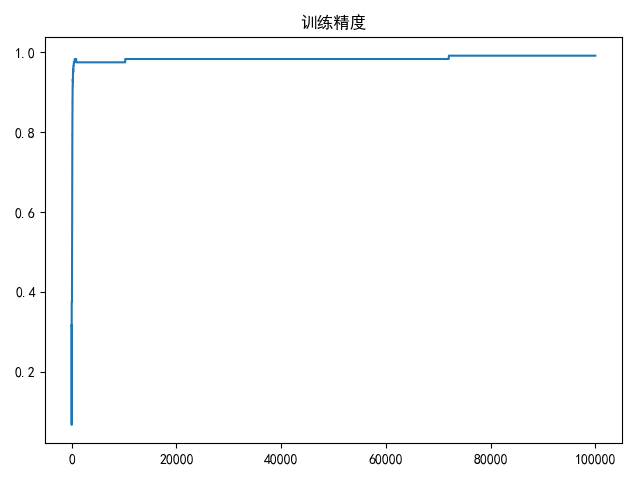softmax回归常用于多分类问题,其输出可直接看成对类别的预测概率
假设对k类标签([1, 2, ..., k])进行分类,那么经过softmax回归计算后,输出一个k维向量,向量中每个值都代表对一个类别的预测概率
下面先以单个输入数据为例,进行评分函数、损失函数的计算和求导,然后扩展到多个输入数据同步计算
对数函数操作 对数求和
对数求差
指数乘法
求导公式 若函数均 可 导
单个输入数据进行softmax回归计算 评分函数 假设使用softmax回归分类数据
其中输入数据
输出结果
其中、
所以对于输入数据
损失函数 利用交叉熵损失(cross entropy loss)作为softmax回归的损失函数,用于计算训练数据对应的真正标签的损失值
Missing or unrecognized delimiter for \left J(\theta) = (-1)\cdot \sum_{j=1}^{k} 1\left{y=j\right} \ln p\left(y=j | x; \theta\right) = (-1)\cdot \sum_{j=1}^{k} 1\left{y=j\right} \ln \frac{e^{\theta_{j}^{T} x}}{\sum_{l=1}^{k} e^{\theta_{l}^{T} x}}
其中函数indicator function),其取值规则为
1 1{a true statement} = 1, and 1{a false statement} = 0
也就是示性函数输入为True时,输出为1;否则,输出为0
对权重向量
Missing or unrecognized delimiter for \left \frac{\varphi J(\theta)}{\varphi \theta_{s}} =(-1)\cdot \frac{\varphi }{\varphi \theta_{s}} \left[ \ \sum_{j=1,j\neq s}^{k} 1\left{y=j \right} \ln p\left(y=j | x; \theta\right) +1\left{y=s \right} \ln p\left(y=s | x; \theta\right) \ \right]
Missing or unrecognized delimiter for \left =(-1)\cdot \sum_{j=1,j\neq s}^{k} 1\left{y=j \right} \frac{1}{p\left(y=j | x; \theta\right)}\frac{\varphi p\left(y=j | x; \theta\right)}{\varphi \theta_{s}} +(-1)\cdot 1\left{y=s \right} \frac{1}{p\left(y=s | x; \theta\right)}\frac{\varphi p\left(y=s | x; \theta\right)}{\varphi \theta_{s}}
分为两种情况
当计算结果正好由
其中
所以
当计算结果不是由
其中
所以
综合上述两种情况可知,求导结果为
Missing or unrecognized delimiter for \left \frac{\varphi J(\theta)}{\varphi \theta_{s}} =(-1)\cdot \sum_{j=1,j\neq s}^{k} 1\left{y=j \right} \frac{1}{p\left(y=j | x; \theta\right)}\frac{\varphi p\left(y=j | x; \theta\right)}{\varphi \theta_{s}} +(-1)\cdot 1\left{y=s \right} \frac{1}{p\left(y=s | x; \theta\right)}\frac{\varphi p\left(y=s | x; \theta\right)}{\varphi \theta_{s}} \ =(-1)\cdot \sum_{j=1,j\neq s}^{k} 1\left{y=j \right} \frac{1}{p\left(y=j | x; \theta\right)})\cdot (-1)\cdot p\left(y=s | x; \theta\right)p\left(y=j | x; \theta\right)\cdot x + (-1)\cdot 1\left{y=s \right} \frac{1}{p\left(y=s | x; \theta\right)}\left[p\left(y=s | x; \theta\right)\cdot x-p\left(y=s | x; \theta\right)^2\cdot x\right] \ =(-1)\cdot \sum_{j=1,j\neq s}^{k} 1\left{y=j \right}\cdot (-1)\cdot p\left(y=s | x; \theta\right)\cdot x + (-1)\cdot 1\left{y=s \right} \left[x-p\left(y=s | x; \theta\right)\cdot x\right] \ =(-1)\cdot 1\left{y=s \right} x - (-1)\cdot \sum_{j=1}^{k} 1\left{y=j \right} p\left(y=s | x; \theta\right)\cdot x
因为Missing or unrecognized delimiter for \left \sum_{j=1}^{k} 1\left{y=j \right}=1
Missing or unrecognized delimiter for \left \frac{\varphi J(\theta)}{\varphi \theta_{s}} =(-1)\cdot \left[ 1\left{y=s \right} - p\left(y=s | x; \theta\right) \right]\cdot x
批量数据进行softmax回归计算 上面实现了单个数据进行类别概率和损失函数的计算以及求导,进一步推导到批量数据进行操作
评分函数 假设使用softmax回归分类数据
其中输入数据
输出结果
其中、
所以对于输入数据
代价函数 利用交叉熵损失(cross entropy loss)作为softmax回归的代价函数,用于计算训练数据对应的真正标签的损失值
Missing or unrecognized delimiter for \left J(\theta) = (-1)\cdot \frac{1}{m}\cdot \sum_{i=1}^{m} \sum_{j=1}^{k} 1\left{y_{i}=j\right} \ln p\left(y_{i}=j | x_{i}; \theta\right) = (-1)\cdot \frac{1}{m}\cdot \sum_{i=1}^{m} \sum_{j=1}^{k} 1\left{y_{i}=j\right} \ln \frac{e^{\theta_{j}^{T} x_{i}}}{\sum_{l=1}^{k} e^{\theta_{l}^{T} x_{i}}}
其中函数
1 1{a true statement} = 1, and 1{a false statement} = 0
也就是示性函数输入为True时,输出为1;否则,输出为0
对权重向量
Missing or unrecognized delimiter for \left \frac{\varphi J(\theta)}{\varphi \theta_{s}} =(-1)\cdot \frac{1}{m}\cdot \sum_{i=1}^{m}\cdot \frac{\varphi }{\varphi \theta_{s}} \left[ \sum_{j=1,j\neq s}^{k} 1\left{y_{i}=j \right} \ln p\left(y_{i}=j | x_{i}; \theta\right)+1\left{y_{i}=s \right} \ln p\left(y_{i}=s | x_{i}; \theta\right) \right]
Missing or unrecognized delimiter for \left =(-1)\cdot \frac{1}{m}\cdot \sum_{i=1}^{m}\cdot \sum_{j=1,j\neq s}^{k} 1\left{y_{i}=j \right} \frac{1}{p\left(y_{i}=j | x_{i}; \theta\right)}\frac{\varphi p\left(y_{i}=j | x_{i}; \theta\right)}{\varphi \theta_{s}} +(-1)\cdot \frac{1}{m}\cdot \sum_{i=1}^{m}\cdot 1\left{y_{i}=s \right} \frac{1}{p\left(y_{i}=s | x_{i}; \theta\right)}\frac{\varphi p\left(y_{i}=s | x_{i}; \theta\right)}{\varphi \theta_{s}}
分为两种情况
当计算结果正好由
其中
所以
当计算结果不是由
其中
所以
综合上述两种情况可知,求导结果为
Missing or unrecognized delimiter for \left \frac{\varphi J(\theta)}{\varphi \theta_{s}} =(-1)\cdot \frac{1}{m}\cdot \sum_{i=1}^{m}\cdot \sum_{j=1,j\neq s}^{k} 1\left{y_{i}=j \right} \frac{1}{p\left(y_{i}=j | x_{i}; \theta\right)}\frac{\varphi p\left(y_{i}=j | x_{i}; \theta\right)}{\varphi \theta_{s}} +(-1)\cdot \frac{1}{m}\cdot \sum_{i=1}^{m}\cdot 1\left{y_{i}=s \right} \frac{1}{p\left(y_{i}=s | x_{i}; \theta\right)}\frac{\varphi p\left(y_{i}=s | x_{i}; \theta\right)}{\varphi \theta_{s}} \ =(-1)\cdot \frac{1}{m}\cdot \sum_{i=1}^{m}\cdot \sum_{j=1,j\neq s}^{k} 1\left{y_{i}=j \right} \frac{1}{p\left(y_{i}=j | x_{i}; \theta\right)})\cdot (-1)\cdot p\left(y_{i}=s | x_{i}; \theta\right)p\left(y_{i}=j | x_{i}; \theta\right)\cdot x_{i} + (-1)\cdot \frac{1}{m}\cdot \sum_{i=1}^{m}\cdot 1\left{y_{i}=s \right} \frac{1}{p\left(y_{i}=s | x_{i}; \theta\right)}\left[p\left(y_{i}=s | x_{i}; \theta\right)\cdot x_{i}-p\left(y_{i}=s | x_{i}; \theta\right)^2\cdot x_{i}\right] \ =(-1)\cdot \frac{1}{m}\cdot \sum_{i=1}^{m}\cdot \sum_{j=1,j\neq s}^{k} 1\left{y_{i}=j \right}\cdot (-1)\cdot p\left(y_{i}=s | x_{i}; \theta\right)\cdot x_{i} + (-1)\cdot \frac{1}{m}\cdot \sum_{i=1}^{m}\cdot 1\left{y_{i}=s \right} \left[x_{i}-p\left(y_{i}=s | x_{i}; \theta\right)\cdot x_{i}\right] \ =(-1)\cdot \frac{1}{m}\cdot \sum_{i=1}^{m}\cdot 1\left{y_{i}=s \right} x_{i} - (-1)\cdot \frac{1}{m}\cdot \sum_{i=1}^{m}\cdot \sum_{j=1}^{k} 1\left{y_{i}=j \right} p\left(y_{i}=s | x_{i}; \theta\right)\cdot x_{i}
因为Missing or unrecognized delimiter for \left \sum_{j=1}^{k} 1\left{y_{i}=j \right}=1
Missing or unrecognized delimiter for \left \frac{\varphi J(\theta)}{\varphi \theta_{s}} =(-1)\cdot \frac{1}{m}\cdot \sum_{i=1}^{m}\cdot \left[ 1\left{y_{i}=s \right} - p\left(y_{i}=s | x_{i}; \theta\right) \right]\cdot x_{i}
梯度下降 权重
矩阵求导如下:
Missing or unrecognized delimiter for \left \frac{\varphi J(\theta)}{\varphi \theta} =\frac{1}{m}\cdot \sum_{i=1}^{m}\cdot \begin{bmatrix} (-1)\cdot\left[ 1\left{y=1 \right} - p\left(y=1 | x; \theta\right) \right]\cdot x\ (-1)\cdot\left[ 1\left{y=2 \right} - p\left(y=2 | x; \theta\right) \right]\cdot x\ …\ (-1)\cdot\left[ 1\left{y=k \right} - p\left(y=k | x; \theta\right) \right]\cdot x \end{bmatrix} =(-1)\cdot \frac{1}{m}\cdot X_{m\times n+1}^T \cdot (I_{m\times k} - Y_{m\times k})
参考:
Softmax regression for Iris classification
Derivative of Softmax loss function
上述计算的是输入单个数据时的评分、损失和求导,所以使用随机梯度下降法进行权重更新,分类
参数冗余和权重衰减 softmax回归存在参数冗余现象,即对参数向量
假设
与此同时,因为损失函数是凸函数,局部最小值就是全局最小值,所以会导致权重在参数过大情况下就停止收敛,影响模型泛化能力
在代价函数中加入权重衰减,能够避免过度参数化,得到泛化性能更强的模型
在代价函数中加入L2正则化项,如下所示:
Missing or unrecognized delimiter for \left J(\theta) = (-1)\cdot \frac{1}{m}\cdot \sum_{i=1}^{m} \sum_{j=1}^{k} 1\left{y_{i}=j\right} \ln p\left(y_{i}=j | x_{i}; \theta\right) + \frac{\lambda}{2} \sum_{i=1}^{k} \sum_{j=0}^{n} \theta_{i j}^{2} = (-1)\cdot \frac{1}{m}\cdot \sum_{i=1}^{m} \sum_{j=1}^{k} 1\left{y_{i}=j\right} \ln \frac{e^{\theta_{j}^{T} x_{i}}}{\sum_{l=1}^{k} e^{\theta_{l}^{T} x_{i}}} + \frac{\lambda}{2} \sum_{i=1}^{k} \sum_{j=0}^{n} \theta_{i j}^{2}
求导结果如下:
Missing or unrecognized delimiter for \left \frac{\varphi J(\theta)}{\varphi \theta_{s}} =(-1)\cdot \frac{1}{m}\cdot \sum_{i=1}^{m}\cdot \left[ 1\left{y_{i}=s \right} - p\left(y_{i}=s | x_{i}; \theta\right) \right]\cdot x_{i}+ \lambda \theta_{j}
代价实现如下:
1 2 3 4 5 6 7 8 9 10 11 12 13 14 15 16 17 18 19 20 21 def compute_loss(scores, indicator, W): """ 计算损失值 :param scores: 大小为(m, n) :param indicator: 大小为(m, n) :param W: (n, k) :return: (m,1) """ return -1 * np.sum(np.log(scores) * indicator, axis=1) + 0.001/2*np.sum(W**2) def compute_gradient(indicator, scores, x, W): """ 计算梯度 :param indicator: 大小为(m,k) :param scores: 大小为(m,k) :param x: 大小为(m,n) :param W: (n, k) :return: (n,k) """ return -1 * x.T.dot((indicator - scores)) + 0.001*W
鸢尾数据集 使用鸢尾(iris)数据集,参考Iris Species
共4个变量:
SepalLengthCm - 花萼长度SepalWidthCm - 花萼宽度PetalLengthCm - 花瓣长度PetalWidthCm - 花瓣宽度
以及3个类别:
Iris-setosaIris-versicolorIris-virginica
1 2 3 4 5 6 7 8 9 10 11 12 13 14 15 16 17 18 19 20 21 22 23 24 25 26 27 28 29 30 31 32 33 34 35 36 37 def load_data(shuffle=True, tsize=0.8): """ 加载iris数据 """ data = pd.read_csv(data_path, header=0, delimiter=',') # print(data.columns) draw_data(data.values, data.columns) def draw_data(data, columns): data_a = data[:50, 1:5] data_b = data[50:100, 1:5] data_c = data[100:150, 1:5] fig = plt.figure(1) plt.scatter(data_a[:, 0], data_a[:, 1], c='b', marker='8') plt.scatter(data_b[:, 0], data_b[:, 1], c='r', marker='s') plt.scatter(data_c[:, 0], data_c[:, 1], c='y', marker='*') plt.xlabel(columns[1]) plt.ylabel(columns[2]) plt.show() fig = plt.figure(2) plt.scatter(data_a[:, 2], data_a[:, 3], c='b', marker='8') plt.scatter(data_b[:, 2], data_b[:, 3], c='r', marker='s') plt.scatter(data_c[:, 2], data_c[:, 3], c='y', marker='*') plt.xlabel(columns[3]) plt.ylabel(columns[4]) plt.show() # 验证是否有重复数据 # for i in range(data_b.shape[0]): # res = list(filter(lambda x: x[0] == data_b[i][0] and x[1] == data_b[i][1], data_c[:, :2])) # if len(res) != 0: # res2 = list(filter(lambda x: x[2] == data_b[i][2] and x[3] == data_b[i][3], data_c[:, 2:4])) # if len(res2) != 0: # print(b[i])
numpy实现 1 2 3 4 5 6 7 8 9 10 11 12 13 14 15 16 17 18 19 20 21 22 23 24 25 26 27 28 29 30 31 32 33 34 35 36 37 38 39 40 41 42 43 44 45 46 47 48 49 50 51 52 53 54 55 56 57 58 59 60 61 62 63 64 65 66 67 68 69 70 71 72 73 74 75 76 77 78 79 80 81 82 83 84 85 86 87 88 89 90 91 92 93 94 95 96 97 98 99 100 101 102 103 104 105 106 107 108 109 110 111 112 113 114 115 116 117 118 119 120 121 122 123 124 125 126 127 128 129 130 131 132 133 134 135 136 137 138 139 140 141 142 143 144 145 146 147 148 149 150 151 152 153 154 155 156 157 158 159 160 161 162 163 164 165 166 167 168 169 170 171 172 173 174 175 176 # -*- coding: utf-8 -*- # @Time : 19-4-25 上午10:30 # @Author : zj import numpy as np import matplotlib.pyplot as plt import pandas as pd from sklearn import utils from sklearn.model_selection import train_test_split import warnings warnings.filterwarnings('ignore') data_path = '../data/iris-species/Iris.csv' def load_data(shuffle=True, tsize=0.8): """ 加载iris数据 """ data = pd.read_csv(data_path, header=0, delimiter=',') if shuffle: data = utils.shuffle(data) # 示性函数 pd_indicator = pd.get_dummies(data['Species']) indicator = np.array( [pd_indicator['Iris-setosa'], pd_indicator['Iris-versicolor'], pd_indicator['Iris-virginica']]).T species_dict = { 'Iris-setosa': 0, 'Iris-versicolor': 1, 'Iris-virginica': 2 } data['Species'] = data['Species'].map(species_dict) data_x = np.array( [data['SepalLengthCm'], data['SepalWidthCm'], data['PetalLengthCm'], data['PetalWidthCm']]).T data_y = data['Species'] x_train, x_test, y_train, y_test = train_test_split(data_x, data_y, train_size=tsize, test_size=(1 - tsize), shuffle=False) y_train = np.atleast_2d(y_train).T y_test = np.atleast_2d(y_test).T y_train_indicator = np.atleast_2d(indicator[:y_train.shape[0]]) y_test_indicator = indicator[y_train.shape[0]:] return x_train, x_test, y_train, y_test, y_train_indicator, y_test_indicator def linear(x, w): """ 线性操作 :param x: 大小为(m,n+1) :param w: 大小为(n+1,k) :return: 大小为(m,k) """ return x.dot(w) def softmax(x): """ softmax归一化计算 :param x: 大小为(m, k) :return: 大小为(m, k) """ x -= np.atleast_2d(np.max(x, axis=1)).T exps = np.exp(x) return exps / np.atleast_2d(np.sum(exps, axis=1)).T def compute_scores(X, W): """ 计算精度 :param X: 大小为(m,n+1) :param W: 大小为(n+1,k) :return: (m,k) """ return softmax(linear(X, W)) def compute_loss(scores, indicator, W, la=2e-4): """ 计算损失值 :param scores: 大小为(m, k) :param indicator: 大小为(m, k) :param W: (n+1, k) :return: (1) """ cost = -1 / scores.shape[0] * np.sum(np.log(scores) * indicator) reg = la / 2 * np.sum(W ** 2) return cost + reg def compute_gradient(scores, indicator, x, W, la=2e-4): """ 计算梯度 :param scores: 大小为(m,k) :param indicator: 大小为(m,k) :param x: 大小为(m,n+1) :param W: (n+1, k) :return: (n+1,k) """ return -1 / scores.shape[0] * x.T.dot((indicator - scores)) + la * W def compute_accuracy(scores, Y): """ 计算精度 :param scores: (m,k) :param Y: (m,1) """ res = np.dstack((np.argmax(scores, axis=1), Y.squeeze())).squeeze() return len(list(filter(lambda x: x[0] == x[1], res[:]))) / len(res) def draw(res_list, title=None, xlabel=None): if title is not None: plt.title(title) if xlabel is not None: plt.xlabel(xlabel) plt.plot(res_list) plt.show() def compute_gradient_descent(batch_size=8, epoches=2000, alpha=2e-4): x_train, x_test, y_train, y_test, y_train_indicator, y_test_indicator = load_data() m, n = x_train.shape[:2] k = y_train_indicator.shape[1] # 初始化权重(n+1,k) W = 0.01 * np.random.normal(loc=0.0, scale=1.0, size=(n + 1, k)) x_train = np.insert(x_train, 0, np.ones(m), axis=1) x_test = np.insert(x_test, 0, np.ones(x_test.shape[0]), axis=1) loss_list = [] accuracy_list = [] bestW = None bestA = 0 range_list = np.arange(0, x_train.shape[0] - batch_size, step=batch_size) for i in range(epoches): for j in range_list: data = x_train[j:j + batch_size] labels = y_train_indicator[j:j + batch_size] # 计算分类概率 scores = np.atleast_2d(compute_scores(data, W)) # 更新梯度 tempW = W - alpha * compute_gradient(scores, labels, data, W) W = tempW if j == range_list[-1]: loss = compute_loss(scores, labels, W) loss_list.append(loss) accuracy = compute_accuracy(compute_scores(x_train, W), y_train) accuracy_list.append(accuracy) if accuracy >= bestA: bestA = accuracy bestW = W.copy() break draw(loss_list, title='损失值') draw(accuracy_list, title='训练精度') print(bestA) print(compute_accuracy(compute_scores(x_test, bestW), y_test)) if __name__ == '__main__': compute_gradient_descent(batch_size=8, epoches=100000)
训练10万次的最好训练结果以及对应的测试结果:
1 2 3 4 # 测试集精度 0.9916666666666667 # 验证集精度 0.9666666666666667
指数计算 - 数值稳定性考虑 在softmax回归中,需要利用指数函数
这个操作不改变结果,如果取值{j} f {j}, 就 能 够 将 向 量 的 取 值 范 围 降 低 , 最 大 值 为
1 2 3 4 5 6 7 8 9 def softmax(x): """ softmax归一化计算 :param x: 大小为(m, k) :return: 大小为(m, k) """ x -= np.atleast_2d(np.max(x, axis=1)).T exps = np.exp(x) return exps / np.atleast_2d(np.sum(exps, axis=1)).T
softmax回归和logistic回归 softmax回归是logistic回归在多分类任务上的扩展,将softmax回归模型可转换成logistic回归模型
针对多分类任务,可以选择softmax回归模型进行多分类,也可以选择logistic回归模型进行若干个二分类
区别在于选择的类别是否互斥 ,如果类别互斥,使用softmax回归分类更为合适;如果类别不互斥,使用logistic回归分类更为合适
相关阅读



